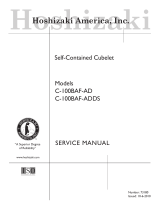
13
c) WV Diagnosis: Check that water enters the water tank. If not, check that the water
supply line shut-off valve is open and screens or external lters are clear. Check for
115VAC at CB C2 (BK) to neutral (W) and CB A2 (V) to neutral (W). If115VAC is not
present at CB C2 (BK) to neutral (W), check wiring from BC. If 115VAC is present
at CB C2 (BK) to neutral (W) and not at CB A2 (V) to neutral (W), replace CB.
If115VAC is present and WV does not energize, check WV coil continuity. Ifopen,
replace WV.
d) FM and PM Diagnosis: Conrm FM and PM de-energize. If not, check for 115VAC at
CB A1 (LBU) to neutral(W) and CB B1 (P) to neutral (W). If 115VAC is present at CB
A1 (LBU) and not at CB B1 (P), CB is still in freeze cycle or CB X1 relay is sticking.
Replace as needed.
e) Normal Harvest Cycle Termination Diagnosis: Fora thermistor check, see
"II.D.Thermistor Check." If evaporator is warming, thermistor reading is correct, and
harvest does not terminate, replace CB.
6) Normal Freeze Cycle. Comp continues. FM and PM energize. HGV and WV
de-energize. CB monitors the cooling of the evaporator via the thermistor located
on the evaporator for freeze termination. When the thermistor drops to 27°F (-3°C),
CB reads 6.8 kΩ from the thermistor and starts 3-min. FT. 27°F (-3°C) or lower must
be maintained the entire 3min. If reading rises above 27°F (-3°C) before 3-min.
FTterminates, 3-min. FT resets. When 27°F (-3°C) or lower is maintained for 3 min.,
5-min. FTT starts.
a) Comp Diagnosis: If Comp de-energizes, check PTC relay continuity. If open,
replace PTC. If closed, check Comp external protector and motor winding continuity.
Replace as needed. If Comp is energized but evaporator is not cooling, check for an
inefficient Comp. See "VIII.B. Performance Data."
b) FM and PM Diagnosis: If FM and PM do not energize, check for 115VAC at CB
B1(P) to neutral (W) and CB A1 (LBU) to neutral (W). If115VAC is present at CB
B1(P) to neutral (W) and not at CB A1 (LBU) to neutral (W), replace CB. If115VAC is
present at CB A1 (LBU) to neutral (W), check FM or PM motor winding continuity, fan
blade or PM impeller for binding, and PM capacitor.
c) HGV and WV Diagnosis: Conrm HGV and WV de-energize. If HGV is energized,
check for 115VAC at CB B1 (P) to neutral(W). If 115VAC is present after PM
energizes, replace CB. If 115VAC is not present and HGV is bypassing, replace
HGV. If WV is energized, check for 115VAC at CB A2 (V) to neutral (W). If 115VAC is
present, replace CB. If115VAC is not present and WV is leaking by, replace WV.
d) Normal Freeze Cycle Termination Diagnosis: 5-min. FTT terminates, harvest cycle
starts. Ifnot, check evaporator temperature where thermistor is mounted and check
the thermistor. See "II.E. Thermistor Check." If evaporator temperature is below 27°F
(-3°C) for more than 8min. and freeze does not terminate, replace CB.
7) Shutdown. When the appliance is running, hold ice in contact with the thermostatic
bulb. BC switch opens within 10 sec., shutting down the appliance. BC is factory set
and generally no adjustment is required. However, adjustment may be needed in
some conditions, particularly at higher altitude locations.
Legend: BC–bin control; CB–control board; Comp–compressor; FM–fan motor; FT–freeze
timer; FTT–freeze termination timer; HGV–hot gas valve; HT–harvest timer;
PM–pump motor; WV–inlet water valve; WVT–inlet water valve timer

























